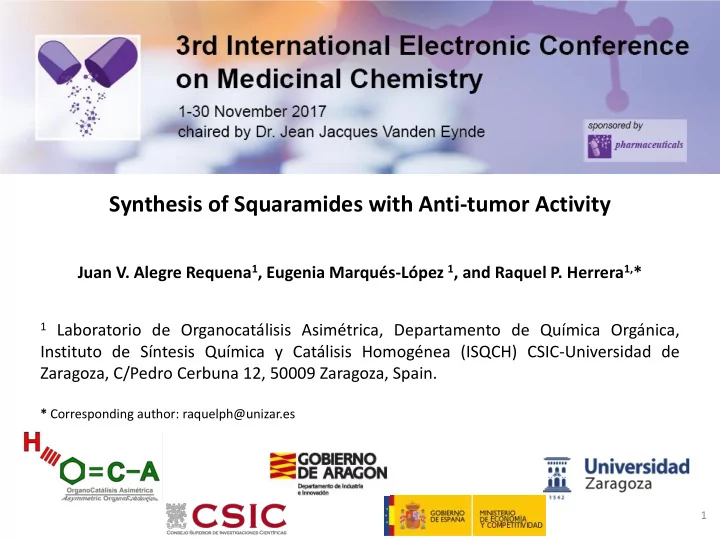

Synthesis of Squaramides with Anti-tumor Activity Juan V. Alegre Requena 1 , Eugenia Marqués-López 1 , and Raquel P. Herrera 1, * 1 Laboratorio de Organocatâ lisis Asimê trica, Departamento de Química Orgâ nica, Instituto de Síntesis Química y Catâ lisis Homogê nea (ISQCH) CSIC-Universidad de Zaragoza, C/Pedro Cerbuna 12, 50009 Zaragoza, Spain. * Corresponding author: raquelph@unizar.es 1
Synthesis of Squaramides with Anti-tumor Activity Graphical Abstract specificity against HGC-27 cells 2
Abstract: In this study, the cytotoxic effects of different squaramides were tested against diverse cancer cells, such as HGC-27, HeLa, T98 and U87 cells, and non-cancer cells, such as EK293, MDCK and Vero cells. We found a disubstituted squaramide that showed an IC 50 of 1.81 μM against HGC-27 cells, which is considerably lower than the IC 50 observed in the rest of the cell lines. Furthermore, the mechanism of action of this compound was evaluated. The results indicate that the decrease in cell viability produced by the squaramide is probably caused by G 0 /G 1 cell cycle arrest and caspase-mediated apoptosis. Additionally, the cell death produced by this compound is accompanied by autophagy induction having a protective effect and no signs of cathepsin-mediated cell death or necroptosis have been observed. The creation of compounds that trigger a specific cell death subroutine is preferred since it might avoid potential side-effects and nonspecific cytotoxic effects. Therefore, this squaramide and its derivatives could be promising molecules for the treatment of gastric carcinoma. Keywords: squaramide; cancer; HGC-27; anti-tumor 3
Introduction Linkers for biomolecules Phosphate isosteres Antibiotics Squaramides In this study … Anti-tumor activity in Medicinal Chemistry 4
Results and discussion Mean IC 50 (95% CI) in μ M [a] Squaramide HeLa cells HGC-27 cells 11.3 (10.3-12.2) 8.1 (7.1-9.2) 1 2 15.2 (13.2-17.4) 8.2 (7.7-8.8) 3 10.8 (9.5-12.3) 4.5 (3.8-5.4) 4 >20 12.8 (11.8-13.7) 5 12.1 (11.4-13.9) 3.0 (2.3-5.0) 6 >20 11.1 (10.5-11.7) 7 >20 3.4 (2.9-4.0) 8 34.6 (28.0-42.9) 1.8 (1.5-2.2) >20 10.8 (10.3-11.2) 9 Cisplatin -- 20.4 (19.8-22.2) Doxorubicin -- 15.82 (9.52-26.2) [a] Measured by a MTT or the SRB assay (Doxorubicin). IC 50 values are indicated as the average SD of three individual experiments. 5
Results and discussion Mean IC 50 (95% CI) in μ M [a] Squaramide HeLa cells HGC-27 cells T98 cells U87 cells HEK293 cells MDCK cells Vero cells 1.8 34.6 (1.5-2.2) 7.2 60.3 9.0 70.2 33.4 8 0.66 [b] (28.0-42.9) (6.1-8.3) (41.5-87.4) (7.1-11.5) (50.6-97.4) (28.0-39.9) (0.57-0.76) [a] Measured by MTT. IC 50 values are indicated as the average SD of three individual experiments. [b] IC 50 measured after 48 h of treatment. specificity against HGC-27 cells 6
Results and discussion Cell cycle distribution of HGC-27 cells with and without treatment of compound 8 (5 μM in DMSO) for 24 h. Doxorubicin (500 nM in DMSO) was included as a positive control. G 0 /G 1 cell cycle arrest 7
Results and discussion caspase-mediated apoptosis Apoptotic effect of squaramide 8 on HGC-27 cells. Cells were treated with 8 and different compounds: Z-VAD-FMK (20 μM ), Z-IETD-FMK (20 μM ), Z- LEHD-FMK (20 μM ), Nec-1 (10 μM ) or Cathepsin inhibitor III (10 μM ). C8- Ceramide (20 μM ) was used as a positive control. The figure shows the quantitative analysis of necrosis, early and late apoptosis. 8
Results and discussion autophagy induction Quantified LC3-II levels respect to β -actin when HGC-27 cells were treated with 8 and different compounds: Cloroquine (CQ, 50 μM in EtOH) and 3-Methyladeninde (3-MA, 2 mM in DMSO). XM462 (10 µM), a known autophagy inducer in HGC-27 cells, was used as a positive control. 9
Conclusions Specificity against HGC-27 cells G 0 /G 1 cell cycle arrest Caspase-mediated apoptosis Autophagy induction 10
Acknowledgments Group E-104 Aragon Government https://hoca.unizar.es 11
Recommend
More recommend